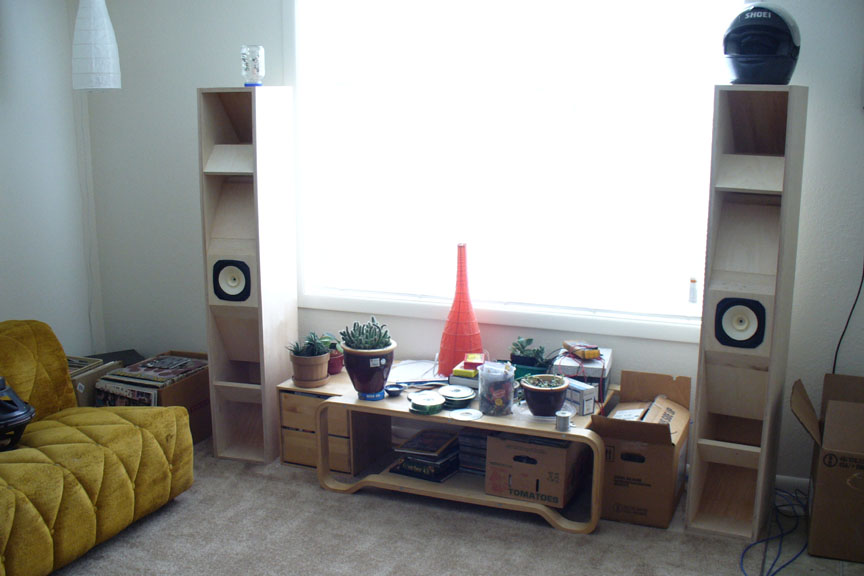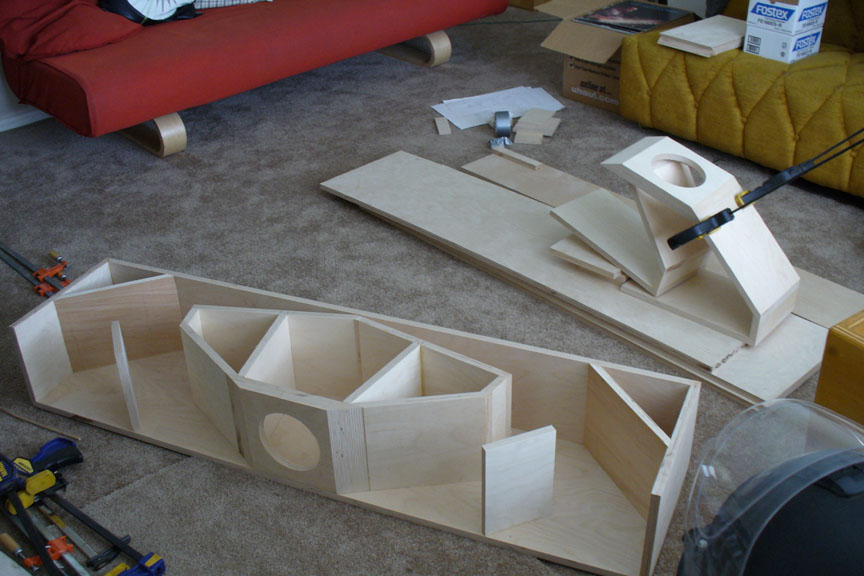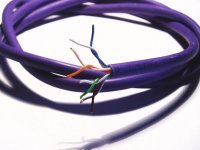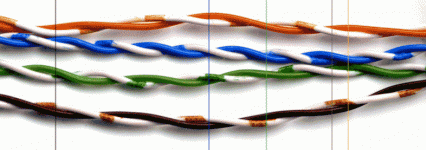The Iris cabinets are all together and running, one week after starting the build. Everything went along smoothly, thanks to the nice plans & drawings over at the frugal-horn site.

I used 13 ply Baltic Birch plywood, kept the panel braces in, and filled the bottom angle deflector cavity with sand. Needless to say, they are kinda heavy! I may still add a bottom plinth for more stability and to bring the drivers up a little bit.

The drivers are fe166es-r. I used them only because I had them. The driver cutout needs to be bigger (than shown on the plans) if you use these! The magnets are silly huge.

To compensate for the wrong driver, I've added 2 ohms of series resistance to the drivers, along with my 'baffle step' cables (using info from here: http://sound.westhost.com/bafflestep.htm ) between the source and the amp.
I still need to line the inside of the chamber, but these things are sounding pretty good as-is - very big sound!

Size comparison with stock fe103 cabinets.
Some more pics are here:
http://www.flickr.com/photos/furtive/sets/72157601689106261/
Thanks to everyone for the great info and help that you've given me through reading the forums.
-Hans

I used 13 ply Baltic Birch plywood, kept the panel braces in, and filled the bottom angle deflector cavity with sand. Needless to say, they are kinda heavy! I may still add a bottom plinth for more stability and to bring the drivers up a little bit.

The drivers are fe166es-r. I used them only because I had them. The driver cutout needs to be bigger (than shown on the plans) if you use these! The magnets are silly huge.

To compensate for the wrong driver, I've added 2 ohms of series resistance to the drivers, along with my 'baffle step' cables (using info from here: http://sound.westhost.com/bafflestep.htm ) between the source and the amp.
I still need to line the inside of the chamber, but these things are sounding pretty good as-is - very big sound!

Size comparison with stock fe103 cabinets.
Some more pics are here:
http://www.flickr.com/photos/furtive/sets/72157601689106261/
Thanks to everyone for the great info and help that you've given me through reading the forums.
-Hans
Hi Hans -lovely build. Very impressive indeed. This is one of the first Iris cabinets to be constructed & certainly the first with ES-Rs, so you're a bit of a trail-blazer here.  Glad you like them.
Glad you like them.
The plinth is a good idea -I used one when I built the prototype Harvey's a year ago (oh boy, was it that long? I'm getting old ) It's worth experimenting with angling them backward slightly too.
) It's worth experimenting with angling them backward slightly too.
Best wishes
Scott
The plinth is a good idea -I used one when I built the prototype Harvey's a year ago (oh boy, was it that long? I'm getting old
 ) It's worth experimenting with angling them backward slightly too.
) It's worth experimenting with angling them backward slightly too. Best wishes
Scott
Hi Scott, thanks for the compliments! I am glad you like them.
They'll be even nicer when I get around to putting a finish on them.
Thanks for the tip; I'll try that out & see what happens.
I also snagged a sheet of open-cell egg crate foam from work to line the inside of the reflex chambers. Hopefully that will reduce the need for as much baffle-step compensation.
Best,
-Hans
They'll be even nicer when I get around to putting a finish on them.

Scottmoose said:[It's worth experimenting with angling them backward slightly too.
Thanks for the tip; I'll try that out & see what happens.
I also snagged a sheet of open-cell egg crate foam from work to line the inside of the reflex chambers. Hopefully that will reduce the need for as much baffle-step compensation.
Best,
-Hans
Thanks 7/10's and Dave!
I am going to start off this post with the warning that any critical listening skills that I probably don't have are further compromised by the fact that my listening room (read: ground floor apartment) has a noise floor that is slightly below the level of a Fiat convertible traveling at 70mph on the freeway. Insulated walls and solid-core doors didn't seem to exist when they built this place. Not to mention c-141 flybys every ten minutes (I live near McChord AFB). Critical listening? Not so much.
Feeding them with a steady diet of bass-heavy stuff has been interesting- at first, there was nothing much happening. Now, after maybe 15-20 hours total, the bass is opening up rather well, much more balanced with the rest of the tones. It will need a subwoofer for the lowest notes, but they don't seem to be lean or thin sounding without a sub.
I'll probably take the 2ohm resistors out of the signal tomorrow & see what happens.
Lining the reflex chamber with egg-crate foam made all sorts of difference, too. That seemed to clear all sorts of things up, just as expected.
These speakers like to play LOUD. I am impressed. Normally I don't listen to music very loud, but with these I keep turning them up just to see what they'll do. Very cool!
Sorry if the post is a little disjointed; I am most certainly NOT the most eloquent writer on earth. As soon as I start typing, I lose track of the thought I wanted to type about.
Thanks again for the designs and plans; using the fe167e these enclosures should be a stunner right out of the box!
-Hans
I am going to start off this post with the warning that any critical listening skills that I probably don't have are further compromised by the fact that my listening room (read: ground floor apartment) has a noise floor that is slightly below the level of a Fiat convertible traveling at 70mph on the freeway. Insulated walls and solid-core doors didn't seem to exist when they built this place. Not to mention c-141 flybys every ten minutes (I live near McChord AFB). Critical listening? Not so much.
Feeding them with a steady diet of bass-heavy stuff has been interesting- at first, there was nothing much happening. Now, after maybe 15-20 hours total, the bass is opening up rather well, much more balanced with the rest of the tones. It will need a subwoofer for the lowest notes, but they don't seem to be lean or thin sounding without a sub.
I'll probably take the 2ohm resistors out of the signal tomorrow & see what happens.
Lining the reflex chamber with egg-crate foam made all sorts of difference, too. That seemed to clear all sorts of things up, just as expected.
These speakers like to play LOUD. I am impressed. Normally I don't listen to music very loud, but with these I keep turning them up just to see what they'll do. Very cool!
Sorry if the post is a little disjointed; I am most certainly NOT the most eloquent writer on earth. As soon as I start typing, I lose track of the thought I wanted to type about.
Thanks again for the designs and plans; using the fe167e these enclosures should be a stunner right out of the box!
-Hans
Hi Hans,
Yes, the lining can make quite a difference -depends on the driver, system & room as to how much. The egg-crate foam is good stuff for lining cabinets. I reckon you'll still want that bit of series resistance, but it'll be interesting to hear your impressions both with & without. They look pretty good to me even without a finish. Wish I could build them like that.
Wish I could build them like that.
C141? That's the Starlifter isn't it?
Yes, the lining can make quite a difference -depends on the driver, system & room as to how much. The egg-crate foam is good stuff for lining cabinets. I reckon you'll still want that bit of series resistance, but it'll be interesting to hear your impressions both with & without. They look pretty good to me even without a finish.
C141? That's the Starlifter isn't it?
HWV said:

To compensate for the wrong driver, I've added 2 ohms of series resistance to the drivers
-Hans
fred76 said:Wow. Excellent build... The plywood you used looks great. If you use a tube amp and somewhat thin gauge internal wiring you won't likely need the series R's. Congrats.
fred
-Hans: looks great. I noticed a thin driver wire, since I know nothing about electrons flowing thru the pipe, I usually use 18gauge speaker wire.
-fred: is there a "proper wire" for the internal wiring? I usually drive the speakers with t-amp, and use the same 18 gauge wires again...
can anyone find me a webpage for proper wire?, partsexpress or allelectronics are usual source for me.
gychang
No, there's no such thing as 'proper' wire. It depends on your cabinet / driver / amp combination. Generally, a twisted pair of 24AWG conductors, extracted from a run of Cat 5 network cable, & then untwisted works well -that's what it looks like Hans has done from the picture (?), & I usually use something similar if it's for a run of 3m or less. If more, then solid core twin + earth mains cable is as good as anything I've come across. A thin wire adds a little series resistance, artificially raising the driver's Qe & propping up the LF.
Scottmoose said:
C141? That's the Starlifter isn't it?
Yep - that's the one! I quick web search says that there were 48 stationed up here, but it looks like they are being phased out by the c-17, so I'm not sure which ones are more common. For living here my whole life, my aircraft recognition is about zero! http://www.fas.org/man/dod-101/sys/ac/c-141.htm
Back on topic:
I am using a single (untwisted) pair of cat5 wires for the internal wiring, and a single (twisted) pair of cat5 wire for the run to the amp. I don't have the patience to untwist that much wire at the moment! I need to dig out my magnet wire & make a few runs out of that.
Amplification right now is two channels of a Sunfire Cinema Grand, using the 'current source' outputs (adds a 1 ohm resistor in series with each channel). I also use an ancient Harmon/Kardon 430 receiver for phono duties.
For tube duties I have a pair of hot-rodded Dynakit MkIII amps (that I'll hook up when the weather is cooler), and a DIY ~2wpc amp that uses a pair of triode-connected el84 per channel (series connected, not push-pull).
Thanks all for the kind words and comments! If there are any other questions, let me know.
-Hans
HWV said:
I am using a single (untwisted) pair of cat5 wires for the internal wiring, and a single (twisted) pair of cat5 wire for the run to the amp.
-Hans
I am confused, so one wire (e.g. black") is used then by definition it would be untwisted?, right? I don't understand a "single (twisted) pair".
gychang
Attachments
Untwisted is easy. You extract a pair of the 24AWG wires from inside the Cat5 that are twisted together. And then you untwist them. 1 wire to the positive. One wire to the negative.
Twisted is even easier. You extract a pair of the 24AWG wires from inside the run of Cat 5 that are twisted together. And then you do nothing, aside from using one wire for positive, and the other for negative.
Twisted is even easier. You extract a pair of the 24AWG wires from inside the run of Cat 5 that are twisted together. And then you do nothing, aside from using one wire for positive, and the other for negative.
The convention we use is that the solid colours are hot, and the striped are ground.
If you use the wires twisted, make sure you use the same colours for each run. Because each pair has a different twist rate, same lengths of twisted pairs are not the same length when you untwist them.
dave
If you use the wires twisted, make sure you use the same colours for each run. Because each pair has a different twist rate, same lengths of twisted pairs are not the same length when you untwist them.
dave
Attachments
If you use the wires twisted, make sure you use the same colours for each run. Because each pair has a different twist rate, same lengths of twisted pairs are not the same length when you untwist them.
CAT 5 wire should be three twist per inch for ALL pairs.
respectfully,
7/10
seventenths said:CAT 5 wire should be three twist per inch for ALL pairs.
Empirical evidence above -- someone else mentioned it and i stripped some fresh to check and take the picture (that was over a year ago).... i just cut a piece off a fesh roll, and each pair still has a different twist rate.
Further i untwisted a brown pair & a blue pair. The twisted pieces were all 17 7/8", the untwisted brown was 18 5/16" and the untwisted blue was 18 5/8" (the tape measure that was handy was only marked in inches)
dave
thanks Scott, Dave for clear explanation on twisted and untwisted wire. Will have to get some Cat 5 cable.
For fullrange speakers in general, it does not seem intuitive when we use thin twisted or untwisted (as Scott recommends) as internal wiring in the speaker cabinet (e.g. "Chili Chang"?) and some of us use thick monster cables from amp to the speaker...
any theory behind this?, or shall I just hooked them up (from amp to speakers) with twisted pair from Cat 5?
gychang
For fullrange speakers in general, it does not seem intuitive when we use thin twisted or untwisted (as Scott recommends) as internal wiring in the speaker cabinet (e.g. "Chili Chang"?) and some of us use thick monster cables from amp to the speaker...
any theory behind this?, or shall I just hooked them up (from amp to speakers) with twisted pair from Cat 5?
gychang
Depends, as ever. Adds a little series resistance, artificially raising the driver's Qe. It's Dave who's the un-twisted Cat 5 specialist -he's got some interesting wires made up.  Using the same wire for internal & external cable makes sense. The longer, the greater the resistance. Give it a try -it costs very little, so you won't loose much.
Using the same wire for internal & external cable makes sense. The longer, the greater the resistance. Give it a try -it costs very little, so you won't loose much.
- Status
- This old topic is closed. If you want to reopen this topic, contact a moderator using the "Report Post" button.
- Home
- Loudspeakers
- Full Range
- Iris

